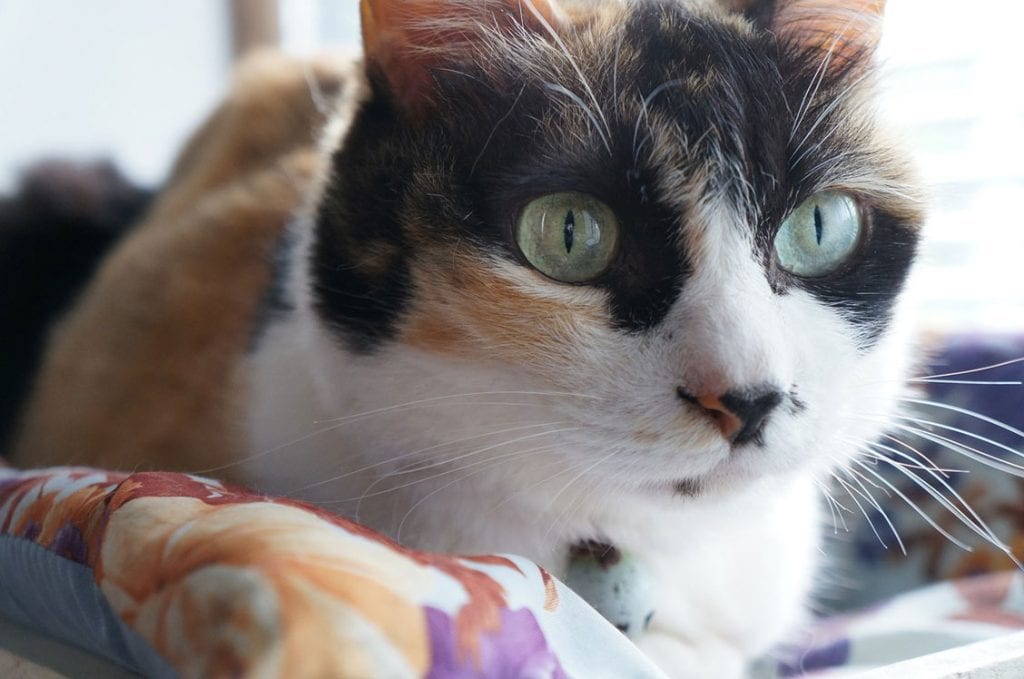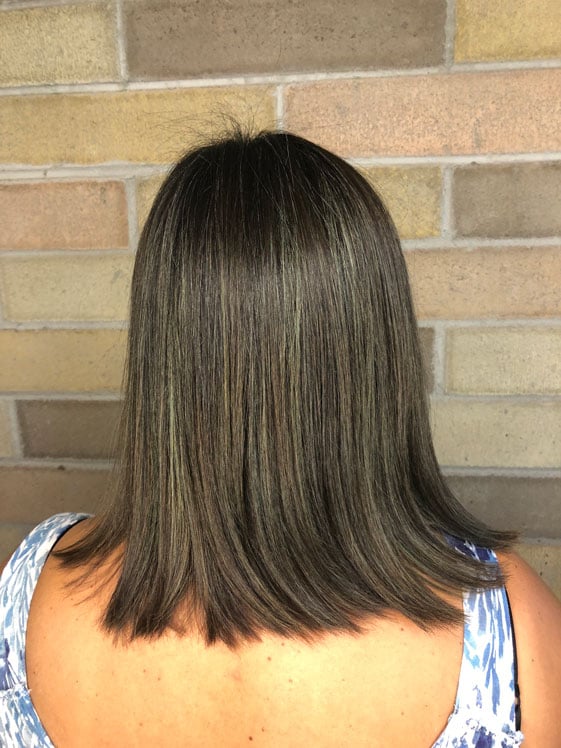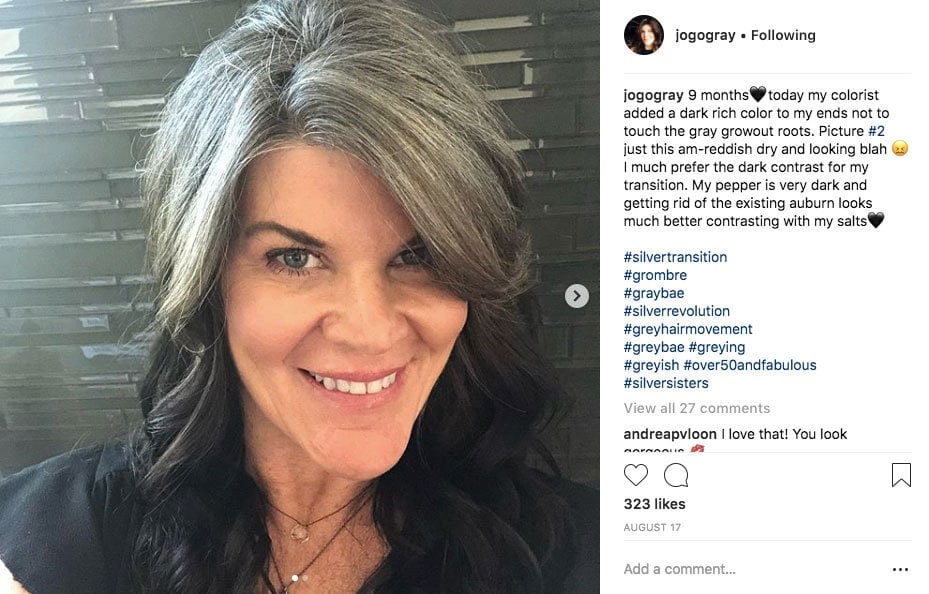A Gray Hair Glossary for Silver Sisters
During the first few weeks of my gray hair transition, I obsessively read everything I could find online about the transition process. Invariably I’d end up scratching my head in confusion at the surprising amount of jargon I encountered. I don’t want you to suffer like I did, so I created this gray hair glossary to help you get started!
Please note that this article may contain affiliate links. You can read my full disclosure at the bottom of the page.
A Comprehensive List of Gray Hair Transition Terms
Balayage
Balayage is one of the salon techniques that some women choose to make their transition to gray more seamless. This article explains balayage better than I ever could.
Basically, it’s like a hand-painting technique to make your grays blend in while you grow them out. Foils are not used.
Monique Parent made this video, which shows the beautiful balayage she received on her already gray hair to give it some oomph.
Blorange
That brassy orange/red/copper color that appears when dyed brunette hair fades.
Here is a shining example:

See that coppery red tint in my fading dyed hair? That’s blorange!
I’ve been pronouncing it to rhyme with “orange”, but I’ve heard other ladies say “blore-ahhnj” (putting kind of a French twist on it). That sounds better and more sophisticated, but BLORANGE (rhyming with ORANGE) makes me laugh, so I’m sticking with it.
If you want to tone down the blorange, remember to check out this post I did for brunettes.
Check out this product list if you have brassy dyed blonde hair and need recommendations, and make sure to read my article all about Yellowing in Gray Hair.
Calico
Multi-colored hair that occurs when you transition cold turkey and your hair
Most of us use the term “calico” due to calico cats, but I saw a lady on a post who compared her hair to an Australian Wild Dog!
It seems like a less flattering term to describe one’s hair (but hilariously apt some days!).

Demarcation Line
The line that appears between your gray hair and your dyed hair. It’s more apparent if your dyed hair is brunette since the contrast between your gray roots and your dark roots can be stark.
But, before you freak out too much about the demarcation line, let me reassure you: Your dyed hair will fade, and as it fades, it starts blending in with your silvers.
My demarcation line was VERY obvious at first (a true skunk stripe!), but not as much now that I’m at 6 months post-dye.
The demarcation line doesn’t bother me, but if it bothers you, that’s when you might want to consider the balayage or highlights/lowlights route.


Grombre
Grombre is a term coined by Martha Truslow Smith (founder of the Grombre Instagram account) and it is used to describe hair with gray roots and darker ends. It’s a play on the word “ombré.”
See “Reverse Ombré” below for a more detailed explanation (they are just two different terms for the same thing).
Highlights & Lowlights
Farah Hurdle, of Maida Salon in San Diego, specializes in this treatment, which she uses to blend gray hair with dyed hair to help ease the transition to fully gray hair.
This is how Farah explained it to me via email:
“When my clients want to transition from a root touch up to a gray blend, I explain how we need to highlight and lowlight the hair for about 6 months. The appointment times are about the same time that they were used to coming in for the root touch up, but the cost is a little bit more. This is a temporary investment into the fact that they can eventually start spacing out appointment times and eventually just come in for haircuts. This…process helps their brain to adjust to seeing the gray.”
Farah Hurdle



Confused about the difference between Balayage and Highlights/Lowlights?
This article in Elle explains it. Basically, the main difference seems to be that balayage is hand-painted and doesn’t require foils, unlike highlights.
If you are going to go gray cold turkey, you don’t need to worry about any of this.
But if you choose to get a salon to help you with your gray transition, I suggest you check out the gray hair Facebook groups to read about the experiences other women have had with these techniques. Some have been good, and some have been bad.
Some hair works better with these techniques than others, so consulting an expert (and other women who are transitioning) is a safe way to move forward.
If you don’t yet have a supportive stylist to help you in your transition, make sure to check out my Gray Friendly Salon Directory to find one in your area!
Reverse Ombré
See “Grombre”, above. This is just another term for that.
This is what happens when your gray hair grows out, and the dyed hair at the end is much darker than the natural gray hair at the top of your head. Bek’s lovely transition photos show you the progress of her reverse ombré.
My pal Jonie from Silver Revolution has a beautiful reverse ombré:

Silvers
Interchangeable with “grays.” Lorraine Massey popularized this in her book Silver Hair: Say Goodbye to the Dye and Let Your Natural Light Shine: A Handbook.
The word “gray” can sound kind of drab, and doesn’t capture the true magic of silver hair! (I’m always fascinated seeing how much my hair sparkles in certain light – like Christmas tinsel! Why the heck was I hiding this light under a bushel?)
Silver Foxes
Gray Haired Men: Think Anderson Cooper, George Clooney, and John Slattery.
Silver Sisters
The online and real-life community of women who have chosen to embrace their gray hair.
Silver Vixens
Gray Haired Women. Think Helen Mirren, Jamie Lee Curtis, and Emmylou Harris.
Now, Professor Katie has 2 more lessons to share before cocktail hour begins:
Gray or Grey, which is correct?
“Here’s a tip: Gray is more common in the United States, and grey is more common in the rest of the English-speaking world.” – from Grammarly
Therefore, in America, we would write “gray is a color” but everywhere else in the English-speaking world, you would write “grey is a colour.”
We just have to be different!
Dyeing or Dying?
One common mistake I see is the misspelling of dye and dyeing. These words have very different meanings:
Dye = Hair Color
Die = To become dead; to cease to exist
Dyeing = The act of coloring your hair
Dying = Ceasing to live; approaching death
In other words, if you don’t want to scare the pants off your friends, relatives, and silver sisters – please check your spelling first!
That’s it for today. Did I forget anything? Please let me know in the comments. Thanks!
Please do me a favor and share this post to social media, as it helps me grow my audience and spread the word about our Silver Revolution! And remember to subscribe to my YouTube Channel and Pinterest Feed for more gray hair tips and product recommendations. Thanks!
Check out my Amazon Shop for all your gray hair needs!
Related Posts:
How to Go Gray at the Salon
What Does It Mean to Be a Silver Sister?
Blue Shampoo for Brunettes Definitely Reduces Brassiness!
7 Weird Things That Happen When You Go
How To Make Your Cold Turkey Gray Hair Transition Fun!









I have kind of dirty blonde hair and a few dark blackish hairs that mingle by my face line and throughout. I used to get light blonde highlights but now having stopped for nearly 6 months my silver is really coming in. Was wondering what I could do to perhaps have very few highlights of dark brown or black added to spice up my look and what you call this procedure? Thanks
Hi, Wanda! That technique is called lowlighting. I talk about it a lot in this video – you might find it helpful!https://youtu.be/xlzFU4rJ46w?si=mxOdk7WQ3Tyi-Hvu
My natural hair color is Strawberry Blonde. I am seventy-one and have been dyeing my hair for over thirty years. I mix light reddish blonde and golden blonde to get as close to my natural color as possible.
My hair has always been something special for me, and I have always gotten many compliments on it over the years. It has become “me”, so to speak. I have almost always had it very long (wish I could post a picture!).
During the pandemic and also during that time, taking care of my mom with Dementia, I didn’t color it until last October. The gray is growing out so slowly (it’s now again October), and is only about two inches grown out in a whole year.
I’m afraid my gray/silver is going to be more gray than silver or white. So I can’t get off the fence!! :-(.
I went natural when my roots began to give my auburn dyed hair the appearance of floating above my scalp after a week. My hair was long, so I began going natural cold-turkey by knotting a scarf turban-style around my hairline, then arranging the colored part to flow over my shoulders. As the grey grew out, the turban was widened. When silver roots began to peek at my crown, I scheduled an appointment to razor cut my hair at the line of demarcation. Tiny threads of color at the ends gave a soft tipped appearance to my new shattered bob hairstyle. Now, my silver hair is my trademark.
I cannot imagine going through this process without your information. Thank you so much! I wasn’t really sure what I was doing when I decided to stop dyeing my hair. Now I’m scrambling to gather knowledge and piece together my plan. And on a personal note: your eyes are GORGEOUS!
Thank you, Mary! So glad this is helping you. And thanks for the nice compliment! My eyes used to be hazel, but they are learning more green these days. Kind of fun!